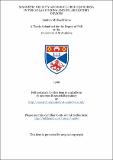Files in this item
Magnetic helicity and force-free equilibria in the solar corona and in laboratory devices
Item metadata
| dc.contributor.advisor | Priest, E. R. (Eric Ronald) | |
| dc.contributor.author | Dixon, Andrew Michael | |
| dc.coverage.spatial | 220 p. | en_US |
| dc.date.accessioned | 2018-06-14T14:32:57Z | |
| dc.date.available | 2018-06-14T14:32:57Z | |
| dc.date.issued | 1988 | |
| dc.identifier.uri | https://hdl.handle.net/10023/14080 | |
| dc.description.abstract | Force-free equilibria are believed to be important in both an astrophysical and a laboratory context as minimum-energy configurations (see, for example, Woltjer, 1958; Taylor, 1974). Associated is the study of magnetic helicity and its invariance. In Chapter Two of this thesis we put forward a means of heating the corona by the rotation of the foot-points of a coronal "sunspot" magnetic field anchored in the photosphere. The method adopted is essentially that of Heyvaerts and Priest (1984), employing Taylor's Hypothesis (Taylor, 1974) and a magnetic helicity evolution equation. A characteristic of the Reversed-Field Pinch device is the appearance, at high enough values of the quantity "volt-seconds over toroidal flux", of a helical distortion to the basic axi-symmetric state. In Chapter Three we look for corresponding behaviour in the "sunspot equilibrium" of the previous chapter, with limited success. However, we go on to formulate a method of calculating general axi-symmetric fields above a sunspot given the normal field component at the photosphere. Chapters Four, Five and Six are concerned with equilibrium force-free fields in a sphere. The main aim here is the calculation minimum-energy configurations having magnetic flux crossing the boundary, and so we employ "relative helicity" (Berger and Field, 1984). In Chapter Four we consider the "P1(cos𝜃)" boundary radial field, finding that the minimum-energy state is always purely symmetric. In Chapter Five we treat the "P2(cos𝜃)" boundary condition. We find in this case that a "mixed state" is theoretically possible for high enough values of the helicity. In Chapter Six, we consider a general boundary field, which we use to model point sources of magnetic flux at the boundary of a spheromak, finding that in practice an axi-symmetric configuration is always the minimum-energy state. Finally, in Chapter Seven we present an extension to the theorem of Woltjer (1958), concerning the minimization of the magnetic energy of a magnetic structure, to include the case of a free boundary subjected to external pressure forces. To illustrate the theory, we have provided three applications, the first to a finite cylindrical flux and the remainder to possible spheromak configurations. | en_US |
| dc.language.iso | en | en_US |
| dc.publisher | University of St Andrews | en |
| dc.subject.lcc | QA927.D5 | |
| dc.subject.lcsh | Magnetohydrodynamics | en |
| dc.title | Magnetic helicity and force-free equilibria in the solar corona and in laboratory devices | en_US |
| dc.type | Thesis | en_US |
| dc.contributor.sponsor | Science and Engineering Research Council (SERC) | en_US |
| dc.contributor.sponsor | Culham Laboratory | en_US |
| dc.contributor.sponsor | University of St Andrews | en_US |
| dc.type.qualificationlevel | Doctoral | en_US |
| dc.type.qualificationname | PhD Doctor of Philosophy | en_US |
| dc.publisher.institution | The University of St Andrews | en_US |
This item appears in the following Collection(s)
Items in the St Andrews Research Repository are protected by copyright, with all rights reserved, unless otherwise indicated.

